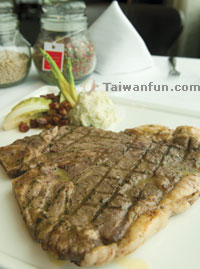
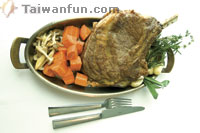
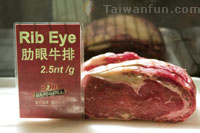
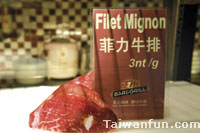
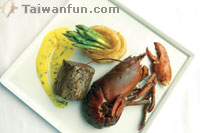
|
Where's the beef in Taichung?
Words and photos by Vesper Stockwell
Translated by Naomi Lai
Beef: It's what's for dinner." That was the ad slogan for a print, TV and radio campaign launched in 1992 in an effort to promote the benefits of beef for a healthy diet in the United States. Given the recent politicizing over US beef imports to Taiwan, it would seem this campaign might be needed more abroad.
Although Taiwan is home to a local breed of cattle referred to as "Huang niu" (黃牛) or, literally, "Yellow Cattle", due to limited pastureland and local production approximately 95% of Taiwan's beef is imported, mostly from Australia, New Zealand, Canada and the United States. Of the numerous pure and hybrid breeds of cattle worldwide, notable beef cattle include Angus, Hereford, and Wagyu for their ability to fetch premium prices. This is particularly true for the highly-prized Kobe beef from the Wagyu breed of Hyogo Prefecture, Japan, where strict breeding tradition includes administering a high-energy feed, beer, and hand-massages to relieve stress and muscle stiffness. Not too shabby.
Besides the different cow breeds, there is also the distinction between those that are grass-fed and corn-fed. Although it's what Nature intended, grass-fed cows are not as profitable in highly competitive mass-production; they do not gain weight nearly as fast as a cow raised or fattened in a feedlot that receives a steady intake of nutrient-rich corn and grain, protein supplements, and growth hormones. A cow foraging for its own food in the open will also naturally develop more muscle and less fat. Due to the high levels of fat and oil in corn feed, the flesh of corn-fed cows develops more marbling (the lines of natural fat that run through the muscles of the cow), resulting in a taste and texture that the USDA grading system promotes and many consumers have grown to love. In spite of its leaner taste and higher price tag, there are those who still prefer grass-fed beef, if not only for the savings in environmental cost and animal welfare. Unfortunately, with "green" stickers slapped on just about anything that might reap a higher price, it is increasingly difficult to discern what qualifies as an "organic", "natural", or "free-range" product. Until consumer demand for strictly organic, grass-fed beef increases, the industry will continue to operate the way it deems most economically efficient.
What are the different cuts of beef?
At Taichung Hotel ONE's Top of ONE restaurant, all steaks served in the restaurant (with the exception of the Cote De Boeuf, which has an option of American or Australian) are all of the highest USDA Prime grade. This grade accounts for an exclusive 2.9% of cows graded in the United States (see attached grading chart) and is sold mainly at top-end restaurants and hotels. Responsible for setting the beef grading standards and conducting routine inspections of cattle farms, the United States Department of Agriculture (USDA) grading system is based on two main criteria: degree of intramuscular fat (marbling) and the maturity of the cattle at the time of slaughter. For example, a younger cow with high muscular fat will receive a higher grading.
Under the leadership of Executive Chef Nicholas Pena-Alvarez, whose 15 years of professional experience includes working all over the world on the Royal Caribbean Cruise Lines, these top-quality steaks are grilled and paired with a variety of fresh condiments and seasonings like shaved black truffles or a brandy green peppercorn sauce. The most popular steak order at Top of ONE is the Cote De Boeuf (NT$3,300). Literally meaning "side of beef" in French, this large, bone-in cut from Ribeye weighs 32 ounces, or nearly 1 kilogram, and is intended to be shared by two people. Another frequently ordered dish, the Porterhouse steak is cut from the rear end of the short loin, maintaining a good size piece of the tenderloin and strip loin, and separated by a T-shaped bone that provides great flavor during cooking. It is offered in two sizes: 14 ounces (NT$1,480) or 18 ounces (NT$1,780).
With a more laid-back steakhouse atmosphere, FM Bar & Grill serves high-quality USDA Choice beef, the next grade after Prime that makes up about 54% of USDA graded cattle. Sold by weight and hand-cut to order, various steak cuts--including Filet Mignon (NT$3/gram), New York Striploin, Rib Eye, and Short Rib (NT$2.5/gram)--are on display for diners to select. Although the Filet Mignon is cut from the tenderloin and generally heralded as the best and most tender part of the animal, the New York Striploin (a.k.a. NY Sirloin) is FM Chef Fred Harold's personal favorite. He explains, "I like to have a little bit of tenderness and a little bit of chew to my steak." He notes that most local customers lean towards the Short Rib and Ribeye, and attests this popularity to the flavor of the gristle and fat in the American Short Rib, which has a tendency to "taste like melted butter".
A beef-and-seafood combination is frequently served in most Western-style steakhouses. At FM Bar & Grill, Beef Tenderloin stuffed with crab meat and asparagus spears (NT$400) can be found on the menu under "The Oskars". At Top of ONE, "Surf & Turf Combinations" include decadent pairings like the Petit Cut Filet & 1/2 Roasted Maine Lobster (6 oz. NT$1,700).
Why order medium-rare as opposed to well-done?
Including Blue, Rare, Medium Rare, Medium, Medium Well, and Well Done, cooking temperatures or steak doneness ultimately depend on personal taste. However, steak connoisseurs typically suggest that expensive cuts and grades be ordered around Medium Rare (internal temperature: 57-63 C)--considerably more cooked than a rare steak but still moist and pink/reddish in color--to fully appreciate the tenderness and flavor for which you are paying. On opposite ends of the spectrum, a Blue steak (internal temperature: 10-29 C) will be totally raw internally and should only be ordered under careful consideration and in environments with strict hygiene, while a Well Done steak (internal temperature: 77 C or above) should obliterate any germs--and tenderness--by being fully cooked with no interior pinkness and being very firm to touch.
Chef Pena-Alvarez says that "sealing in the juices" is actually a misnomer; while searing the sides of a steak does give it a brown coating that caramelizes the natural flavors in the blood, it doesn't actually make the steak more moist. To debunk another myth, he adds, "Not all cows sleep standing up." When asked if he's ever participated in cow-tipping, however, he replies with a wry, "No comment." And, since he also claims he can carve up half a cow carcass in four hours and de-bone a chicken in 40 seconds, I got no beef with that.
Where to get a good Western-style steak in Taichung:
Top of ONE (Hotel ONE)
(04) 2303-1234
532, YingCai Rd, 46F
USDA Prime steak with a great city view.
FM Bar & Grill
(04) 2251-4500
1, Shizheng N Rd, Sec 1, 2F
(Le Free Shopping Center on WenXin Rd, Sec 1)
Sunday is Steak Night with 20% off all steak meals.
Smooth European Restaurant
(04) 2329-3468
5-7, Lane 50, JingCheng Rd
International variety with U.S., New Zealand and Wagyu Kobe steaks in a classy setting.
Gordon Biersch Brewery Restaurant
(04) 2310-7678
533, DaDun Rd
All-USDA Beef steaks in American bistro-style brewhouse.
Cosby Saloon
(04) 2461-9557
166-35, XiTun Rd, Sec 3
Australian/New Zealand steaks; all-American Western bar setting.
Ruth's Chris
(04) 2323-2872
367 TaiZhong Gang Rd, Sec 1, 26F
USDA Prime with high-end setting and service.
Costco Wholesale
289, WenXin S 3rd Rd, Nantun District; (04) 3704-2855
American membership warehouse store. USDA certified beef in various cuts for cooking at home.
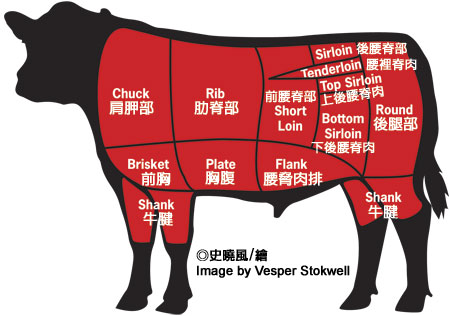
USDA Beef Grades
◎ U.S. Prime- Highest in quality and intramuscular fat; limited supply.
◎ U.S. Choice- High quality, most popular and widely available in the food service industry and retail markets; lower and less evenly-distributed fat content than Prime-grade beef.
◎ U.S. Select (formerly Good)- Lowest grade, commonly sold at retail; leaner meat is less juicy and tender, yet economical.
◎ U.S. Standard- Lower quality, lacking marbling and mild in flavor; yet still tender and produced from young animals.
◎ U.S. Commercial- Low quality, lacking tenderness; produced from mature animals.
◎ U.S. Utility*
◎ U.S. Cutter*
◎ U.S. Canner*
★Utility, Cutter, and Canner grades are seldom used in food service operations and primarily used by processors and canners to make ground beef and other meat products.
|